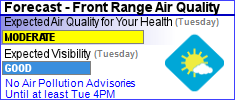Indirect Source Emissions Reductions
This emission control strategy aims to mitigate emissions associated with the construction and operation of indirect sources. Indirect sources, a term that comes from the Clean Air Act, include activities associated with facilities, structures, buildings, et cetera, which can reasonably be expected to cause or induce substantial mobile source activity that result in emissions of air pollutants that might reasonably be expected to interfere with the attainment and maintenance of the national ambient air quality standards. These types of facilities can also be called trip attractors and generators.
The goal of preparing an Indirect Source Program(s) to be endorsed by the RAQC Board and considered/adopted as a regulation by the Air Quality Control Commission are to reduce emissions from high traffic locations, where the construction or operation of a facility, building, or structure attracts, or may attract, mobile sources of pollution. For more information on the legal authority to consider these programs, please see this January 2025 memo.
The RAQC developed an Indirect Source Emissions Control Strategy Development Overview document to provide a brief, publicly-accessible summary of its efforts on this topic and later developed strategy briefing papers for three indirect source-related strategies as part of its Control Strategy Blueprint development process. These briefing papers can be found on the Blueprint webpage. Dr. Jana Milford, current Air Quality Control Commissioner and former RAQC Board member, wrote a memo to the Air Quality Control Commission in July 2024 that provides additional background on indirect sources from her perspective.
RAQC Indirect Sources Technical Work Group
The RAQC started a Indirect Sources Technical Work Group in September 2024 to explore potential indirect source program options with stakeholders in parallel to the interagency project described below. The Work Group formed four subgroups to explore opportunities to reduce emissions from specific indirect source types: warehouses, entertainment venues, airports, and universities. To sign up for upcoming meetings, the IS mailing list, and access meeting materials, please go to the IS Technical Work Group page.
Interagency Indirect Source Project
The IS project conducted a series of phased analyses from early 2023 through early 2025 to provide data and information for use in drafting a subsequent IS proposal for regulations and/or programs to reduce these emissions. The project sponsors had identified the following steps in developing an IS Program:
- Identify and review existing Indirect Source Programs in other regions around the country;
- Identify potential benefits and roadblocks for establishing a program in the DM/NFR region; and
- If appropriate measures are identified for development, then draft a regulatory framework to establish a program in the DM/NFR region.
Phase 1 reports and research:
- The report for Equity Analysis of Indirect Sources provided by FHU (August 2023).
- The report for Colorado Indirect Sources Market Study provided by FHU (August 2023).
- The report for Analysis of Future Indirect Sources provided by FHU (August 2023).
- The report for Analysis of Existing Indirect Sources provided by FHU (August 2023).
- A Comparative Analysis of Indirect Source Rules for California San Joaquin Valley and South Coast Cases (October 2023)
- A preliminary analysis (December 2019) of the strategy is available for review.
Phase 2 reports and research:
- The report for Traffic Analysis of Indirect Sources provided by FHU (January 2025).
Associated Presentations:
- Indirect Source Program Phase One (August 2023)
- Comparative Analysis Presentation (January 2024)

